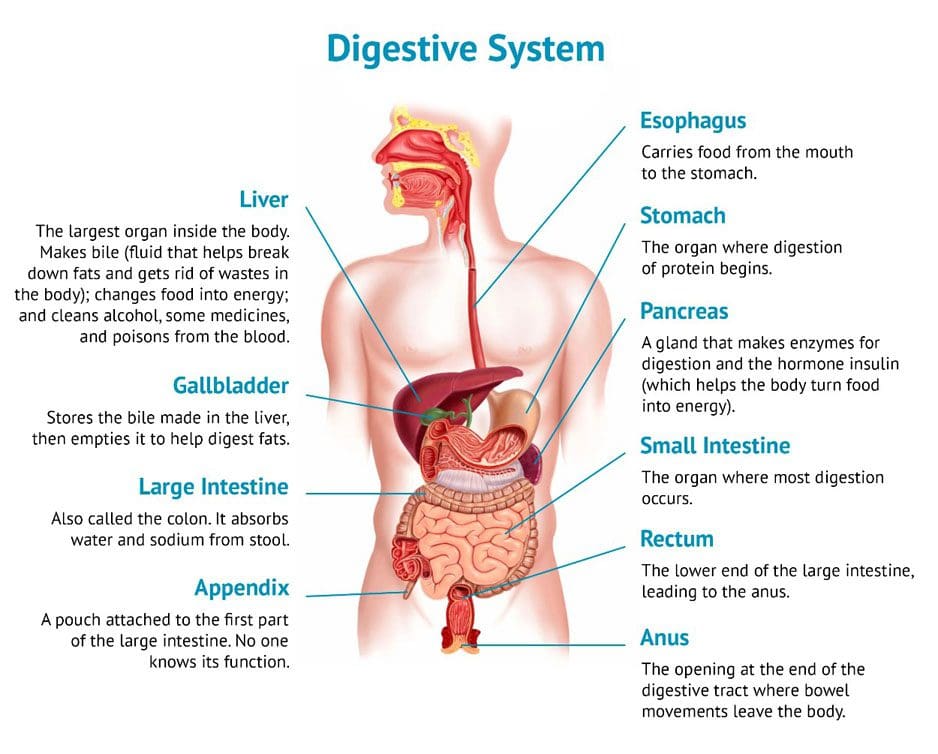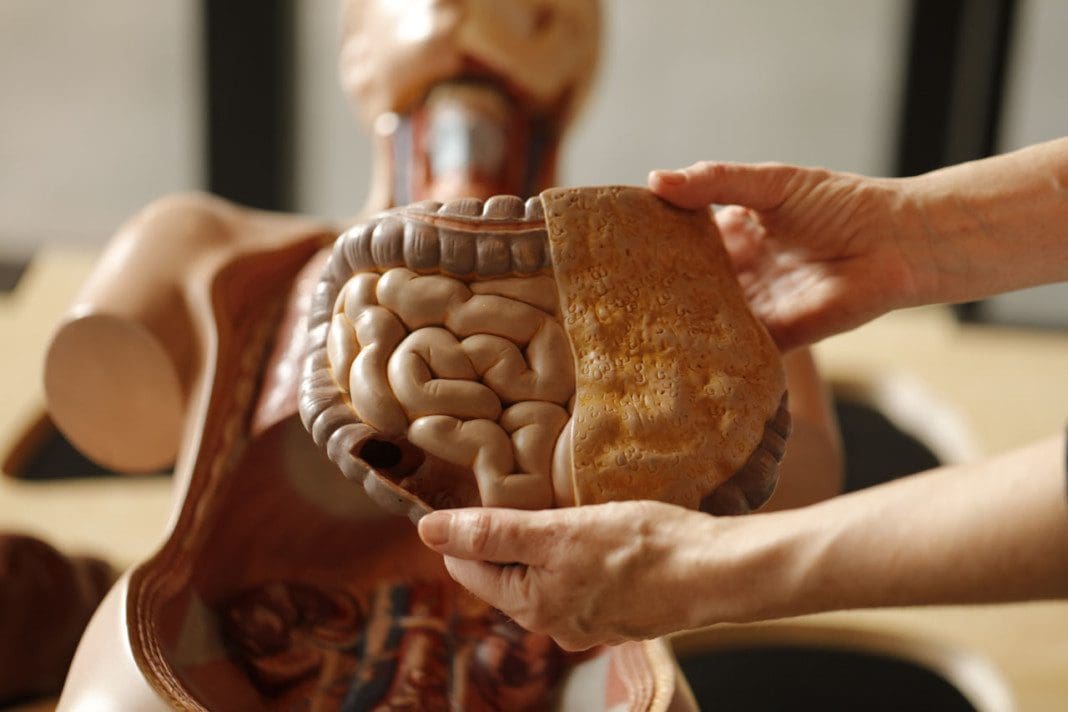The body needs food for fuel, energy, growth, and repair. The digestive process breaks down food into a form the body can absorb and use for fuel. The broken-down food gets absorbed into the bloodstream from the small intestine, and the nutrients are carried to the cells throughout the body. Understanding how the organs work together to digest food can help with health goals and overall health.
Table of Contents
The Digestive Process
The organs of the digestive system are the following:
- Mouth
- Esophagus
- Stomach
- Pancreas
- Liver
- Gallbladder
- Small intestine
- Large intestine
- Anus
The digestive process starts with the anticipation of eating, stimulating the glands in the mouth to produce saliva. The digestive system’s primary functions include:
- Mixing food
- Moving food through the digestive tract – peristalsis
- The chemical breakdown of food into smaller absorbable components.
The digestive system converts food into its simplest forms, which include:
- Glucose – sugars
- Amino acids – protein
- Fatty acids – fats
Proper digestion extracts nutrients from food and liquids to maintain health and function properly. Nutrients include:
- Carbohydrates
- Proteins
- Fats
- Vitamins
- Minerals
- Water
Mouth and Esophagus
- The food is ground up by the teeth and moistened with saliva to swallow easily.
- Saliva also has a special chemical enzyme that starts breaking down carbohydrates into sugars.
- Muscular contractions of the esophagus massage the food into the stomach.
Stomach
- The food passes through a small muscle ring into the stomach.
- It gets mixed with gastric chemicals.
- The stomach churns the food to break it down further.
- The food is then squeezed into the first part of the small intestine, the duodenum.
Small Intestine
- Once in the duodenum, the food mixes with more digestive enzymes from the pancreas and bile from the liver.
- The food passes into the lower parts of the small intestine, called the jejunum and the ileum.
- Nutrients are absorbed from the ileum, lined with millions of villi or thread-like fingers that facilitate the absorption.
- Each villus is connected to a mesh of capillaries, which is how nutrients get absorbed into the bloodstream.
Pancreas
- The pancreas is one of the largest glands.
- It secretes digestive juices and a hormone called insulin.
- Insulin helps regulate the amount of sugar in the blood.
- Problems with insulin production can lead to conditions like diabetes.
Liver
The liver has several different roles that include:
- Breaks down fats using bile stored in the gallbladder.
- Processes proteins and carbohydrates.
- Filters and processes impurities, medications, and toxins.
- Generates glucose for short-term energy from compounds like lactate and amino acids.
Large Intestine
- A large reservoir of microbes and healthy bacteria live in the large intestine and play an important role in healthy digestion.
- Once the nutrients have been absorbed, the waste is passed into the large intestine or bowel.
- Water is removed, and the waste gets stored in the rectum.
- It is then passed out of the body through the anus.
Digestive System Health
Ways to keep the digestive system and the digestive process healthy include:
Drink More Water
- Water helps the food flow more easily through the digestive system.
- Low amounts of water/dehydration are common causes of constipation.
Add More Fiber
- Fiber is beneficial to digestion and helps with regular bowel movements.
- Incorporate both soluble and insoluble fiber.
- Soluble fiber dissolves in water.
- As soluble fiber dissolves, it creates a gel that can improve digestion.
- Soluble fiber may reduce blood cholesterol and sugar.
- It helps your body improve blood glucose control, which can aid in reducing your risk for diabetes.
- Insoluble fiber does not dissolve in water.
- Insoluble fiber attracts water into the stool, making it softer and easier to pass with less strain on the bowels.
- Insoluble fiber can help promote bowel health and regularity and supports insulin sensitivity which can help reduce the risk of diabetes.
Balanced Nutrition
- Eat fruit and vegetables daily.
- Choose whole grains over processed grains.
- Avoid processed foods in general.
- Choose poultry and fish more than red meat and limit processed meats.
- Cut down on sugar.
Eat Foods with Probiotics or Use Probiotic Supplements
- Probiotics are healthy bacteria that help combat unhealthy bacteria in the gut.
- They also generate healthy substances that nourish the gut.
- Consume probiotics after taking antibiotics that often kill all the bacteria in the gut.
Eat Mindfully and Chew Food Slowly
- Chewing food thoroughly helps to ensure the body has enough saliva for digestion.
- Chewing food thoroughly also makes it easier for nutritional absorption.
- Eating slowly gives the body time to digest thoroughly.
- It also allows the body to send cues that it is full.
How The Digestive System Works
References
GREENGARD, H. “Digestive system.” Annual review of physiology vol. 9 (1947): 191-224. doi:10.1146/annurev.ph.09.030147.001203
Hoyle, T. “The digestive system: linking theory and practice.” British journal of nursing (Mark Allen Publishing) vol. 6,22 (1997): 1285-91. doi:10.12968/bjon.1997.6.22.1285
https://www.merckmanuals.com/home/digestive-disorders/biology-of-the-digestive-system/overview-of-the-digestive-system
https://www.niddk.nih.gov/health-information/digestive-diseases/digestive-system-how-it-works
Martinsen, Tom C et al. “The Phylogeny and Biological Function of Gastric Juice-Microbiological Consequences of Removing Gastric Acid.” International journal of molecular sciences vol. 20,23 6031. 29 Nov. 2019, doi:10.3390/ijms20236031
Ramsay, Philip T, and Aaron Carr. “Gastric acid and digestive physiology.” The Surgical clinics of North America vol. 91,5 (2011): 977-82. doi:10.1016/j.suc.2011.06.010
Professional Scope of Practice *
The information herein on "The Digestive Process: Functional Medicine Sciatica Clinic" is not intended to replace a one-on-one relationship with a qualified health care professional or licensed physician and is not medical advice. We encourage you to make healthcare decisions based on your research and partnership with a qualified healthcare professional.
Blog Information & Scope Discussions
Welcome to El Paso's Premier Wellness and Injury Care Clinic & Wellness Blog, where Dr. Alex Jimenez, DC, FNP-C, a Multi-State board-certified Family Practice Nurse Practitioner (FNP-BC) and Chiropractor (DC), presents insights on how our multidisciplinary team is dedicated to holistic healing and personalized care. Our practice aligns with evidence-based treatment protocols inspired by integrative medicine principles, similar to those found on this site and our family practice-based chiromed.com site, focusing on restoring health naturally for patients of all ages.
Our areas of multidisciplinary practice include Wellness & Nutrition, Chronic Pain, Personal Injury, Auto Accident Care, Work Injuries, Back Injury, Low Back Pain, Neck Pain, Migraine Headaches, Sports Injuries, Severe Sciatica, Scoliosis, Complex Herniated Discs, Fibromyalgia, Chronic Pain, Complex Injuries, Stress Management, Functional Medicine Treatments, and in-scope care protocols.
Our information scope is multidisciplinary, focusing on musculoskeletal and physical medicine, wellness, contributing etiological viscerosomatic disturbances within clinical presentations, associated somato-visceral reflex clinical dynamics, subluxation complexes, sensitive health issues, and functional medicine articles, topics, and discussions.
We provide and present clinical collaboration with specialists from various disciplines. Each specialist is governed by their professional scope of practice and their jurisdiction of licensure. We use functional health & wellness protocols to treat and support care for musculoskeletal injuries or disorders.
Our videos, posts, topics, and insights address clinical matters and issues that are directly or indirectly related to our clinical scope of practice.
Our office has made a reasonable effort to provide supportive citations and has identified relevant research studies that support our posts. We provide copies of supporting research studies upon request to regulatory boards and the public.
We understand that we cover matters that require an additional explanation of how they may assist in a particular care plan or treatment protocol; therefore, to discuss the subject matter above further, please feel free to ask Dr. Alex Jimenez, DC, APRN, FNP-BC, or contact us at 915-850-0900.
We are here to help you and your family.
Blessings
Dr. Alex Jimenez DC, MSACP, APRN, FNP-BC*, CCST, IFMCP, CFMP, ATN
email: coach@elpasofunctionalmedicine.com
Multidisciplinary Licensing & Board Certifications:
Licensed as a Doctor of Chiropractic (DC) in Texas & New Mexico*
Texas DC License #: TX5807, Verified: TX5807
New Mexico DC License #: NM-DC2182, Verified: NM-DC2182
Licensed as a Multi-State Advanced Practice Registered Nurse (APRN*) in Texas & Multistate
Multistate Compact RN License by Endorsement (42 States)
Texas APRN License #: 1191402, Verified: 1191402 *
Florida APRN License #: 11043890, Verified: APRN11043890 *
* Prescriptive Authority Authorized
ANCC FNP-BC: Board Certified Nurse Practitioner*
Compact Status: Multi-State License: Authorized to Practice in 40 States*
Graduate with Honors: ICHS: MSN-FNP (Family Nurse Practitioner Program)
Degree Granted. Master's in Family Practice MSN Diploma (Cum Laude)
Dr. Alex Jimenez, DC, APRN, FNP-BC*, CFMP, IFMCP, ATN, CCST
My Digital Business Card
RN: Registered Nurse
APRNP: Advanced Practice Registered Nurse
FNP: Family Practice Specialization
DC: Doctor of Chiropractic
CFMP: Certified Functional Medicine Provider
IFMCP: Institute of Functional Medicine
CCST: Certified Chiropractic Spinal Trauma
ATN: Advanced Translational Neutrogenomics














